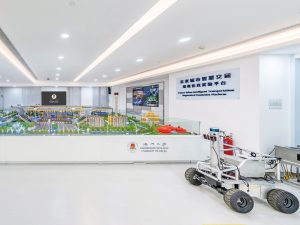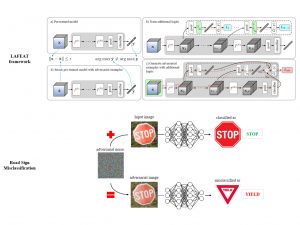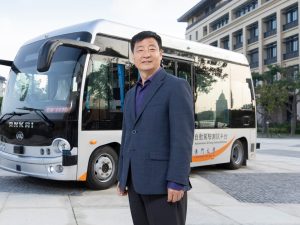Intelligent transportation is a key component of smart cities as it enables people to avoid risks on the road. Among the many technologies in this field, autonomous driving and the intelligent networking of vehicles and infrastructure have drawn a lot of attention and become global technology battlegrounds. Focusing on these core technologies in the future of transportation, an intelligent transportation research group of the State Key Laboratory of Internet of Things for Smart City (SKL-IOTSC) at the University of Macau (UM) strives to solve scientific problems to enable the coexistence of manual and autonomous driving in large-scale, complex, and uncertain environments. This will contribute to the development of a safe, efficient, and intelligent transportation system.
Key Intelligent Driving Technologies
Autonomous driving technology, an iconic application area of artificial intelligence, is trending in the global automobile industry today. However, implementing this technology still presents many challenges. The research group, led by Xu Chengzhong, dean of the Faculty of Science and Technology, interim director of the Institute of Collaborative Innovation and chair professor in the Department of Computer and Information Science, focuses on two major scientific topics. These topics include ‘swarm intelligence and cooperative control of connected vehicles in large-scale and complex situations’ and ‘high robustness and adaptability of autonomous driving in uncertain open environments.’ The group studies the applications of advanced technologies such as the Internet of Things (IoT), 5G communications, cloud computing, and artificial intelligence in autonomous driving.
In 2020, a research project led by the group, titled ‘Key Technologies and Platforms for Collaborative Intelligence‐driven Autonomous Vehicles’ was awarded funding by the Macao Science and Technology Development Fund as a key R&D project in artificial intelligence, becoming one of the largest research projects in Macao’s history. The project brought together a number of leading institutes in the field of autonomous driving in China. In the past three years, UM has collaborated with the Shenzhen Institute of Advanced Technology of the Chinese Academy of Sciences (CAS) and proposed a new model robustness evaluation for autonomous driving technology, laying the foundation for a truly safe autonomous driving system. The research results were presented at the Conference on Computer Vision and Pattern Recognition (CVPR) 2021, which had a paper acceptance rate of only 4.59 per cent. CVPR is one of two important conferences in artificial intelligence. The team’s results were also presented at the Conference on Neural Information Processing Systems 2022, and will be showcased again at CVPR in 2023.
In addition, the group has made breakthroughs in the perceptual, cognitive, decision-making, and planning ability of intelligent driving technology and has published over 100 papers in top conferences and journals, such as international academic conferences recommended by the China Computer Federation (category A and B) and IEEE journals. The group has also won several awards in major international competitions, including the CVPR2021 Security AI Challenger and CVPR2022 3D Object Detection Competition.
Autonomous Bus
On the road, traffic scenarios vary with a high degree of complexity and diversity, so it is difficult to cover all scenarios with data-driven models. This is a key issue to address in the field of autonomous driving. To enable safe and intelligent driving, the group is constantly working to improve vehicles’ ability to detect the external environment by using various perception technologies. The group has developed the first autonomous bus in Macao in collaboration with experts from the Shenzhen Institute of Advanced Technology of CAS, the National University of Defense Technology, Baidu, and Shenzhen Haylion Technologies. In the project, the researchers combined technologies such as artificial intelligence, big data, IoT, and cloud computing to collect traffic information. Based on a transfer learning method, the autonomous bus is able to operate safely and reliably in an open and uncertain environment, integrating itself with the environment to form an efficient transportation system.
According to Prof Xu, in autonomous driving mode, the bus can detect both static and dynamic obstacles, including vehicles and pedestrians, as well as traffic signs, zebra crossings, and traffic lights, by using a depth perception model based on data collected by multiple sensors. The bus would know when to slow down or stop based on the actual situation on the road. The group also applied a high-precision positioning method that integrates laser radar, inertial navigation, and simultaneous localisation and mapping (SLAM) algorithm to realise self-planning and navigation of the autonomous bus to improve driving safety.
In August 2022, the autonomous bus left the UM campus for a 17-day intelligent driving performance test. The bus travelled across the border via the Lotus Bridge between Macao and Hengqin and navigated the roads within the Traditional Chinese Medicine Science and Technology Industrial Park of Co-operation between Guangdong and Macao, where the Zhuhai UM Science & Technology Research Institute Phase II is located. By combining the results of performance tests on the UM campus with the latest research findings, the researchers managed to significantly enhance the bus’s capabilities in environmental adaptability and perception, localisation, obstacle detection, and path planning. Moreover, the group deployed a 5G-based vehicle-infrastructure cooperative system on the bus to strengthen its capabilities using cloud and edge computing technology.
As the next step in the project, the research team will conduct in-depth studies on vehicle-infrastructure cooperation in complex traffic environments, intelligent driving technologies based on cloud and edge computing technology, as well as test platforms for industrial applications. The autonomous bus will be further tested on open roads in Macao and roads within the UM campus. It is expected that UM members will experience autonomous driving technology on campus in the near future.
Combined Virtual and Real Transportation Platform
To investigate the swarm intelligence and collaborative control of networked vehicles in complex situations in which manual and autonomous driving coexist, the group has built the Combined Virtual and Real Transportation Platform that allows autonomous vehicles to be tested virtually in scenarios that are difficult to simulate in the real world. Using the platform, the group also performs stable, reliable, and controllable tests on single vehicle intelligence as well as vehicle-infrastructure cooperation systems to further improve the robustness and adaptability of autonomous vehicles in open and uncertain environments, so as to realise panoramic perception, precise navigation, intelligent decision-making, and efficient control.
In November 2022, using the platform and metaverse technology, the group built the Macao Car Racing Metaverse (MoCAM) Platform, the first of its kind in Macao, aiming to create world-leading simulated and real scenarios. The MoCAM Platform can simulate the flow of vehicles and people and superimpose real autonomous vehicles to create a multi-dimensional and mixed-reality metaverse platform. It can also calculate the adaptability of autonomous vehicles to various traffic scenarios on the road to prevent accidents.
According to Prof Xu, the group will make good use of UM’s advanced technology in the field of intelligent driving and leverage the policies and geographical advantages of the Guangdong-Macao In-Depth Cooperation Zone in Hengqin. It will also provide automation and standardisation testing and certification services for autonomous vehicle manufacturers in Guangdong and Macao, and strive to build a first-class international intelligent driving test site in the Guangdong-Hong Kong-Macao Greater Bay Area.
Text / Kelvin U, Trainee UM Reporter Zhu Jiangge
Photo / Jack Ho, with some provided by the interviewee
English Translation / Winky Kuan
Source: UMagazine ISSUE 27



